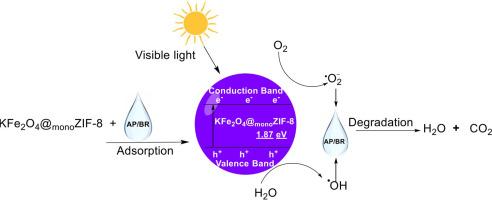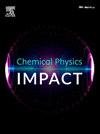沸石咪唑酸骨架强化铁酸钾净化黄芪粉FG和亮红B污染水
IF 4.3
Q2 CHEMISTRY, PHYSICAL
引用次数: 0
摘要
吸附和光催化是从水系统中去除染料的已知方法。但存在去除率差、成本高、吸附剂/催化剂再生能力差、吸附剂/催化剂回收率低等缺点。为此,制备了咪唑酸分子筛骨架增强铁酸钾(KFe2O4@monoZIF-8),以去除水中的黄褐红FG (AP)和亮红B (BR)染料。表征结果显示KFe2O4@monoZIF-8具有结构良好的衍射图样,晶粒尺寸为31.24 nm,能带隙为1.87 eV。扫描电镜图像显示了一个均匀的表面,具有形状相似的不同大小的颗粒。同时,能量色散x射线能谱和元素作图证实了组成元素为K、Fe、O、C和Zn。有趣的是,KFe2O4@monoZIF-8作为吸附剂和光催化剂。在无可见光条件下,KFe2O4@monoZIF-8吸附AP和BR的平衡吸附量分别为17.85±0.8 mg g-1和15.00±0.8 mg g-1,吸附过程符合拟二级动力学模型。在可见光照射下进行光催化降解,对AP和BR的去除率分别为98.80±1.20%和95.2±1.30%。KFe2O4@monoZIF-8在AP和BR二元混合溶液中对AP和BR的光降解效率分别为78.00±1.10%和70.00±1.10%。在第7个再生处理周期,KFe2O4@monoZIF-8的再生能力达到70%以上。KFe2O4@monoZIF-8与以前发表的用于去除水溶液中的染料的材料相比,效果更好。该研究表明KFe2O4@monoZIF-8是一种很有前途的去除水系统染料的材料。本文章由计算机程序翻译,如有差异,请以英文原文为准。

Purification of astrazon pink FG and brilliant Red B contaminated water using zeolitic imidazolate framework enhanced potassium ferrite
Adsorption and photocatalysis are known methods for removing dyes from aqueous systems. However, they may suffer from shortcomings like poor dye removal, high cost, poor adsorbent/catalyst regeneration and poor adsorbent/catalyst recovery. Therefore, a zeolitic imidazolate framework enhanced potassium ferrite (KFe2O4@monoZIF-8) was prepared to remove astrazon pink FG (AP) and brilliant Red B (BR) dyes from the water system. The characterization results of KFe2O4@monoZIF-8 revealed a well-structured diffraction pattern with a crystallite size of 31.24 nm and an energy bandgap of 1.87 eV. The scanning electron micrograph image revealed a homogeneous surface with similarly shaped particles of different sizes. At the same time, the energy-dispersive X-ray spectroscopy and elemental mapping confirmed the component elements to be K, Fe, O, C and Zn. Interestingly, KFe2O4@monoZIF-8 functions as an adsorbent and a photocatalyst. The adsorption of AP and BR by KFe2O4@monoZIF-8 in the absence of visible light revealed an equilibrium sorption capacity of 17.85±0.8 and 15.00±0.8 mg g-1, respectively, in a process described by pseudo-2nd-order kinetic model. Furthermore, when subjected to photocatalytic degradation under visible light irradiation, the removal efficiencies towards AP and BR became 98.80±1.20 and 95.2 ± 1.30 %, respectively. KFe2O4@monoZIF-8 in a binary mixed solution of AP and BR exhibited a photodegradation efficiency of 78.00±1.10 and 70.00±1.10 % towards AP and BR, respectively. In addition, KFe2O4@monoZIF-8 exhibited a regeneration capacity above 70 % at the 7th regeneration treatment cycle. KFe2O4@monoZIF-8 compared favourably with previously published materials for removing dyes in an aqueous solution. This study revealed KFe2O4@monoZIF-8 as a promising material for removing dyes from the water system.
求助全文
通过发布文献求助,成功后即可免费获取论文全文。
去求助
来源期刊

Chemical Physics Impact
Materials Science-Materials Science (miscellaneous)
CiteScore
2.60
自引率
0.00%
发文量
65
审稿时长
46 days
 求助内容:
求助内容: 应助结果提醒方式:
应助结果提醒方式:


